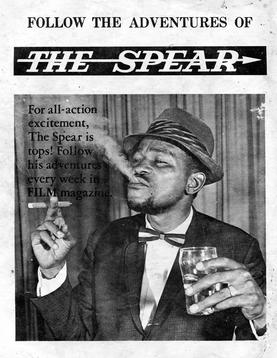TBT
- Thread starter Meria
- Start date
Introvert
Elder Lister
Ssabasajja
Elder Lister
That must be Luanda.View attachment 938
Market day
Anglututu
Elder Lister
Inaitwa bilauriwhen tea was tea it was served in this cups
View attachment 876
Nattydread
Elder Lister
Mkubwa, tuangushie FILM, ile ya Lance Spearman, Inspector Victor, Lemie na Sonia.The African Drum.’ – extract from ‘South African Drumbeats’, TIME Magazine, 1952.
Drum magazine was established in March 1951 in Cape Town, and launched by journalist and broadcaster Bob Crisp. It was initially known as “African Drum”, with its aim being one intended to depict Black South Africans as ‘noble savages’, and this under the editorship of Bob Crisp. Copies were said to have been sent by the South African government abroad, this serving as evidence over their success in managing the ‘Bantu’. The content of the magazine comprised of mainly folk tales and tribal preaching, this also seeing it become unsuccessful financially despite its readership of about 20 000. This all changed when Crisp was replaced and the publication grew when former pilot and son of mining baron Jim Bailey took over the magazine in 1951. The magazine set its headquarters in Johannesburg (the hub and chief magnet with its mines, shebeens, dancehalls and snappy dressers) and was renamed Drum. Drum was given a total transformation, with its content now reflecting vibrant urban black culture. African nationalist movements used the magazine now as a platform, and it continued to grow and influence the emergent urban black culture. An editorial board that consisted of some of the leading political and cultural figures of the time was selected, and this done to ensure that the magazine reflected Black life. This board included such notables as: Henry (Mr Drum) Nxumalo, Can Themba,
Todd Matshikiza, Nat Nakasa, Lewis Nkosi and others such as William Bloke Modisane, Arthur Maimane, and Casey Motsisi.
It wasn’t only the writers – the pictures were also important. The main photographer and artistic director was Jürgen Schadeberg who arrived in South Africa in 1950 after leaving a war ravaged Berlin. He became one of the rare European photographers to photograph the daily lives of Black people. He trained a generation of rising black photographers, including Ernest Cole, Bob Gosani and later Peter Magubane. Magubane joined Drum because “they were dealing with social issues that affected black people in South Africa.
Drum published its first major story in March 1952, entitled ‘Bethal Today’. It was an eight page, investigative article on a farm in Bethal were labourers encountered gross abuse. One of the Drum journalists Henry Nxumalo “Mr Drum” went undercover, posing as one of the labourers on the farm, this done to uncover needed information and material for the story. His story, which uncovered the harsh and abusive conditions at the farm was accompanied by undeniable proof from pictures taken by his fellow work mate Schandeburg. This exposure, from the story and the pictures worked as a force to get the government to enforce change in the way farms were managed in Bethal.
Initially Drum was not intended to deal with political issues but the editorial board saw it meaningless to publish the magazine without any political reference and thus render the publication incomplete.
Apartheid and political issues continued to be covered in Drum, and these included amongst others the Sophiatown forced evictions, the Defiance Campaign which was launched by the ANC, Sharpeville massacre, and many other stories of atrocities. It proved to be an essential vehicle in voicing resistance in the 1950s and also drive towards an equal society. Resistance was united and mobilized through or by it, and a good example being of pictures that accompanied Nelson Mandela’s statement ‘We Defy’, found in the August 1952 issue. The Nationalist responded with apartheid crackdowns and treason trials.
Drum described the world of the urban Black; the culture, the colour, dreams, ambitions, hopes and struggles. Lewis Nkosi described Drum’s young writers as the new Africancut adrift from the tribal reserve – urbanized, eager, fast-talking and brash.
Also documented by Drum was, multiracial affairs and integrated communities which were never shown in other publications. An example of such a scenario is that captured by Ranjith Kally in 1957, of images of White people in shebeens.
By May 1965 Drum had lost its zest and simply became a fortnightly supplement magazine. 1968 saw its revival. 1984 saw the acquisition of Drum by Naspers, who are the published of City Press and True Love.
source: https://historydesignlove.wordpress.com/
View attachment 879View attachment 880
Lance Spearman was widely regarded as the James Bond of English speaking Africa[3] from Kenya on the East Coast to South Africa, and across the West Coast in Nigeria and Ghana. At its zenith, Lance Spearman had over half a million fans[4] across the continent until the series was discontinued in 1972.[5]
The fictional Spear is a sophisticated African super-spy, detective and superhero, all rolled into one,[6][7] who sports a goatee, smokes expensive cigars, drinks Whisky on the rocks, and dresses in well tailored suits complete with a bow tie and a Panama hat. Spear likes buxom women and drives the Corvette Sting Ray.[8][self-published source?] Spear is an expert marksman and is skilled at karate and boxing.

Lance Spearman - Wikipedia
 en.wikipedia.org
en.wikipedia.org
Mwalimu-G
Elder Lister
Quink and Pelican brands were for very rich people. most of us ordinary folk wrote with Ostrich.where on running out of Quink(that wasn't ink
we still had Son of SamsomMkubwa, tuangushie FILM, ile ya Lance Spearman, Inspector Victor, Lemie na Sonia.
View attachment 979

Lance Spearman - Wikipedia
en.wikipedia.org
mzeiya
Elder Lister
Did she get 'blacked'?Do you remember this film? Very controversial indeed
View attachment 919
hehe
Last edited by a moderator:
Kabuda
Elder Lister
Kutengeneza viatu.Who knows what this was used for?
What is it called?
Wahenga ebu tu tulie tafadhali.
View attachment 896
Thanks for TBT mkubwa.
welcomeKutengeneza viatu.
Thanks for TBT mkubwa.
our kijiji (nyumba ya wazee) is now complete
Liberty
Elder Lister
Liberty
Elder Lister
Afro
Elder Lister
Salimia hio midget
Mwalimu-G
Elder Lister
It is called a shoemaker's last.Kutengeneza viatu.
Jambo Kabuda?
i thought its shoemakers anvil, heheIt is called a shoemaker's last.
Jambo Kabuda?
